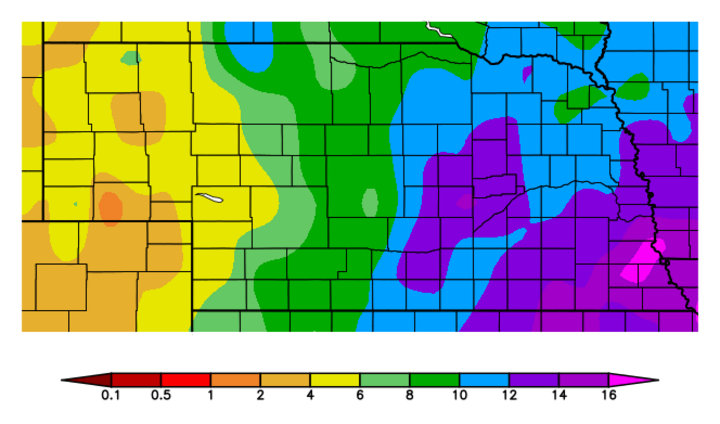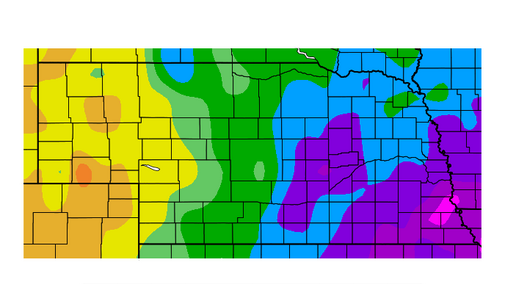
Spring topdressing winter wheat with fertilizer N is an effective way to enhance winter wheat production and profitability. One should evaluate stands, and check soil moisture and fertilizer and wheat prices before determining N needs for the crop this spring. The cold winter and erosion following the snowmelt and heavy rain in March may have resulted in soil stand loss. On the other hand, high soil water in eastern Nebraska may favor yield (Figure 1).
Topdressing should be completed prior to jointing. If you have pre-plant soil nitrate-N, use that information together with the amount of N applied in the fall to adjust the topdress N rate (Table 1). If the yield is expected to be above 75 bushels per acre, apply an additional 20 lbs N per acre. One has to be aware that excessive soil N due to high residual N in soil from past management or high N input in spring can promote vegetative growth to an extent that lodging becomes an issue, especially with high soil moisture in the spring.
| Residual nitrate-N | Wheat price, $ per bushel | ||
|---|---|---|---|
| Average ppm in a 3-ft depth | 3.5 | 4 | 4.5 |
| 2 | 65 | 75 | 85 |
| 4 | 45 | 55 | 65 |
| 6 | 25 | 35 | 45 |
| 8 | 5 | 15 | 20 |
| 10 | 0 | 0 | 0 |
If managed well, adequate soil moisture and favorable growing conditions in the spring increase tillering and wheat yield. As wheat yield increases, the requirement for N increases. Nitrogen availability also directly affects grain protein content. In order to increase wheat yield and protein levels without causing lodging loss, N must be properly managed in the soil and be available for plant uptake during grain development. It is recommended that an additional 20 lb N per acre be applied for each one percent increase in grain protein desired, up to a maximum of 40 lbs N per acre. Please see the UNL publication, Fertilizing Winter Wheat (EC 143), for N recommendations.
Because of our wet late winter-early spring, there is still plenty of time to apply N before wheat reaches the jointing stage. A potential issue with the good soil moisture is that it poses a risk for N volatilization loss from sources containing urea (both urea and nitrogen solutions) when N is applied to wet soils. A urease inhibitor should be used if urea or urea ammonium nitrate is applied and the urea is not likely to be incorporated with rainfall or irrigation within five days of application. The urease inhibitors that have known efficacy have the active ingredient (NBPT or NPPT). For more information on effective inhibitors, consult this North Dakota State University Extension publication.

